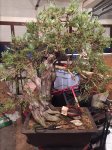Vance Wood
Lord Mugo
Outside of understanding artistic principles and the horticultural needs of a particular tree there is nothing more important in bonsai than wiring. It is absolutely imperative that you master this sub-art and wiring is in itself an art. You will not learn this art without a concentrated effort to do so.
I think most people on this forum know that I am self taught but the art of wiring has for the most part eluded me on the levels I needed to accomplish the type of visions I was picturing in my mind. Two or three years ago I posted a video on the wiring of one of my Mugo Pines. After posting the video Adair butchered it and pointed out just how bad and ineffective the wiring was. He was right.
I owe him a great deal of gratitude in kicking me in the ass enough that I considered my own efforts and looked at them through different eyes. I then set forth to master this art. I sought out every site I could find and watched countless hours of professionals wiring. I was able to improve why skills 100 fold and since then have been able to elevate my bonsai to a level much higher than I thought possible. You don't learn this stuff why sitting on your butt believing that as time goes on you will get it together. The truth is you will get things together up to a point but, if you want to go beyond that point you must put forth the effort.
So for what it's worth Adair: Thank You my friend I owe you.
I think most people on this forum know that I am self taught but the art of wiring has for the most part eluded me on the levels I needed to accomplish the type of visions I was picturing in my mind. Two or three years ago I posted a video on the wiring of one of my Mugo Pines. After posting the video Adair butchered it and pointed out just how bad and ineffective the wiring was. He was right.
I owe him a great deal of gratitude in kicking me in the ass enough that I considered my own efforts and looked at them through different eyes. I then set forth to master this art. I sought out every site I could find and watched countless hours of professionals wiring. I was able to improve why skills 100 fold and since then have been able to elevate my bonsai to a level much higher than I thought possible. You don't learn this stuff why sitting on your butt believing that as time goes on you will get it together. The truth is you will get things together up to a point but, if you want to go beyond that point you must put forth the effort.
So for what it's worth Adair: Thank You my friend I owe you.





